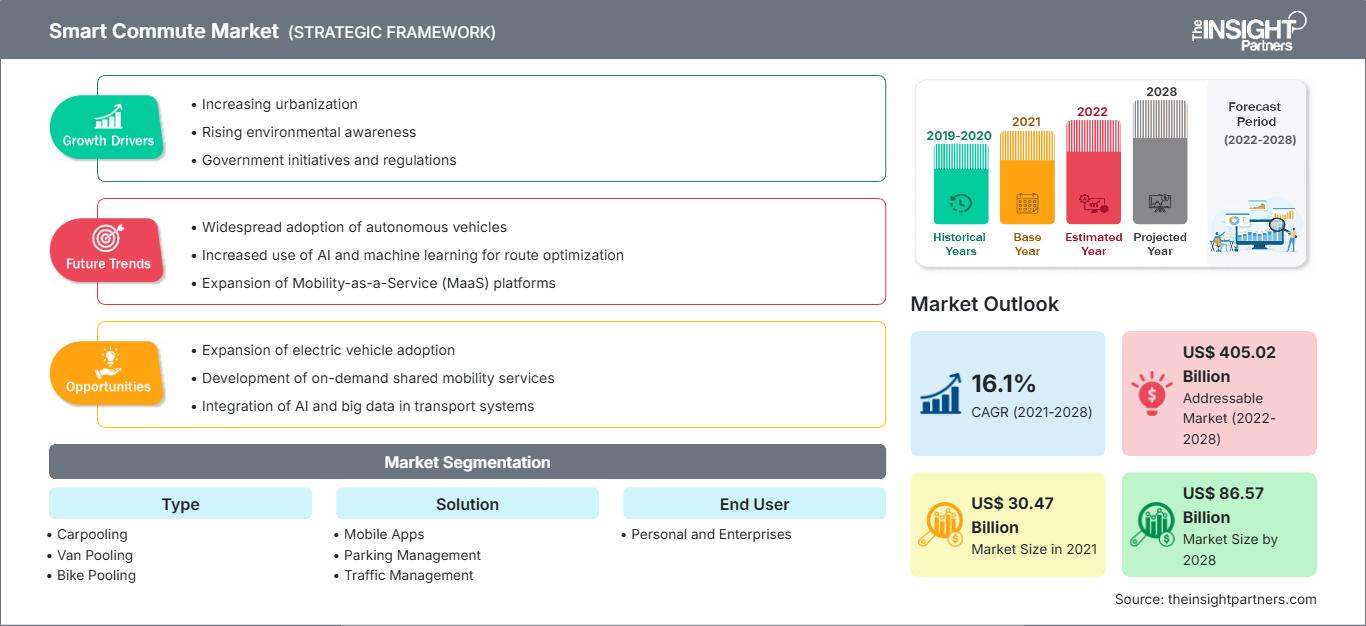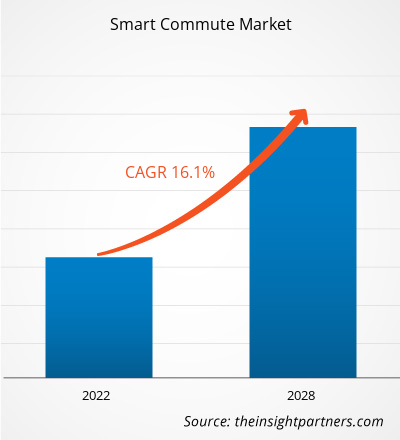Si prevede che il mercato del pendolarismo intelligente crescerà da 30.469,49 milioni di dollari nel 2021 a 86.568,73 milioni di dollari entro il 2028; si stima una crescita a un CAGR del 16,1% dal 2021 al 2028.
Il pendolarismo intelligente è definito come lo spostamento regolare tramite carpooling, vanpooling, bicicletta, ciclisti o metropolitana. Le aziende di trasporto pubblico, i governi e altri stakeholder hanno sviluppato una strategia completa che considera il viaggio intelligente e lo condivide con il pubblico per costruire trasporti più efficienti nelle aree metropolitane. Il pendolarismo intelligente ha un impatto positivo sull'ambiente riducendo la congestione del traffico e le emissioni di gas serra.
Carpooling, bike-sharing, vanpooling e altre opzioni di pendolarismo ecocompatibili sono disponibili attraverso i servizi di pendolarismo intelligente. Offre ai lavoratori d'ufficio un'opzione di trasporto per scegliere un percorso di viaggio più efficiente che riduce la congestione del traffico e le spese di trasporto. Uno dei fattori che stimolano la crescita del mercato dello smart commuting è il crescente numero di abitanti delle città, che porta a un aumento del tasso di ricambio generazionale. I servizi di trasporto condiviso hanno ottenuto un'accettazione universale e vengono incoraggiati da governi e enti ambientalisti in quanto contribuiscono a ridurre le emissioni. Consentono inoltre di ridurre il numero di auto private, il che dovrebbe alimentare la crescita del mercato dello smart commuting nei prossimi anni.
In Nord America, la necessità di smart commuting è stata alimentata dalla crescente preferenza per i servizi di car pooling tra i pendolari che si recano in ufficio, che allevierebbero la congestione del traffico e preverrebbero i danni ambientali. Inoltre, la crescita del settore turistico, i progressi tecnologici e le politiche governative favorevoli sono altri fattori che guidano la crescita del mercato dello smart commuting nordamericano. In Europa, si prevede che l'aumento del trend della mobilità come servizio e l'aumento della base di utenti dei servizi di ride-sharing creeranno opportunità redditizie per gli operatori del mercato.
In Europa, a causa delle crescenti preoccupazioni per il riscaldamento globale, la congestione stradale e la dipendenza dall'energia estera, gli smart commuting stanno diventando sempre più popolari. La pratica di imporre pedaggi alle automobili con un solo occupante, imposta nel 2012, ha portato a un enorme aumento dell'uso di mezzi di trasporto intelligenti da parte dei consumatori europei.
Personalizza questo rapporto in base alle tue esigenze
Potrai personalizzare gratuitamente qualsiasi rapporto, comprese parti di questo rapporto, o analisi a livello di paese, pacchetto dati Excel, oltre a usufruire di grandi offerte e sconti per start-up e università
Mercato del pendolarismo intelligente: Approfondimenti strategici

-
Ottieni le principali tendenze chiave del mercato di questo rapporto.Questo campione GRATUITO includerà l'analisi dei dati, che vanno dalle tendenze di mercato alle stime e alle previsioni.
Impatto della pandemia di COVID-19 sul mercato dei servizi di smart commuting
L'epidemia di COVID-19 ha avuto un impatto significativo sul settore dei trasporti. La domanda di servizi di carpooling e vanpooling si è ridotta a livello globale nel 2020 a causa del COVID-19. Il mercato mondiale dei servizi di smart commuting ha registrato un calo considerevole della generazione di fatturato nel 2020 rispetto al 2019, in parte a causa dei lockdown e della riluttanza dei clienti a utilizzare i servizi di ride-sharing anche dopo la revoca delle normative. Le aziende di ride-sharing cercano costantemente di mantenere la fiducia di conducenti e passeggeri in termini di sicurezza e igiene.
Approfondimenti di mercato: Mercato del pendolarismo intelligente
Tendenza crescente della mobilità come servizio
Le persone che non possono permettersi un'auto possono usufruire di servizi di mobilità senza interruzioni. Secondo il Bureau of Transportation Statistics, il costo medio di possesso e gestione di un veicolo è di circa 8.858 dollari, ipotizzando 15.000 chilometri di guida all'anno. La mobilità come servizio riduce questi costi per l'utente massimizzando l'utilizzo di servizi di trasporto come il carpooling e il ride-hailing. Riduce inoltre la congestione del traffico e le emissioni complessive delle automobili nelle città. Di conseguenza, il carpooling e il ride-hailing abilitati digitalmente gestiscono in modo efficiente la domanda di trasporto e offrono un'alternativa comoda ed ecologica alla proprietà di un'auto privata. Inoltre, secondo le statistiche, il 55% della popolazione mondiale vive attualmente in città e le stime suggeriscono che entro il 2050 circa il 68% della popolazione vivrà in città. Il rapido ritmo dell'urbanizzazione sta già causando congestione del traffico. Il concetto di mobilità come servizio (MaaS) potrebbe rappresentare una scelta migliore per ridurre la congestione del traffico, sfruttando maggiormente le infrastrutture di trasporto pubblico e privato esistenti. Si prevede che l'urgente richiesta di soluzioni efficaci per gestire il traffico nelle città intelligenti in modo più rapido, economico e pratico alimenterà la crescita del mercato MaaS entro il 2028. Pertanto, si prevede che la crescente tendenza alla mobilità come servizio (MaaS) alimenterà la crescita del mercato globale dello smart commuting.
Approfondimenti sul mercato dello smart commuting in base alla tipologia
In base alla tipologia, il mercato dello smart commuting è segmentato in carpooling, vanpooling, bike pooling, metropolitana e altri. Si prevede che il segmento del carpooling detenga una quota significativa nel mercato globale dello smart commuting e che cresca al CAGR più elevato. Il pendolarismo intelligente è definito come lo spostamento regolare da un punto all'altro tramite carpooling, vanpooling, bicicletta, ciclisti o metropolitana.
Approfondimenti sul mercato del pendolarismo intelligente basato sulle soluzioni
In base alla soluzione, il mercato del pendolarismo intelligente è segmentato in app mobili, gestione dei parcheggi, gestione del traffico e altri. Si prevede che il segmento delle app mobili detenga una quota significativa nel mercato globale del pendolarismo intelligente e che cresca al CAGR più elevato. Si registra un crescente utilizzo di applicazioni mobili in modalità di viaggio in automobile per ridurre tempi, costi ed emissioni dei veicoli.
Approfondimenti sul mercato del pendolarismo intelligente basato sull'utente finale
In base all'utente finale, il mercato del pendolarismo intelligente è suddiviso in privato e aziendale. Si prevede che il segmento aziendale detenga una quota significativa nel mercato globale del pendolarismo intelligente e che cresca a un CAGR più elevato.
Mercato del pendolarismo intelligenteLe tendenze e i fattori regionali che hanno influenzato il mercato degli Smart Commute durante il periodo di previsione sono stati ampiamente spiegati dagli analisti di The Insight Partners. Questa sezione analizza anche i segmenti e la geografia del mercato degli Smart Commute in Nord America, Europa, Asia-Pacifico, Medio Oriente e Africa, America Meridionale e Centrale.
Ambito del rapporto di mercato Smart Commute
| Attributo del rapporto | Dettagli |
|---|---|
| Dimensioni del mercato in 2021 | US$ 30.47 Billion |
| Dimensioni del mercato per 2028 | US$ 86.57 Billion |
| CAGR globale (2021 - 2028) | 16.1% |
| Dati storici | 2019-2020 |
| Periodo di previsione | 2022-2028 |
| Segmenti coperti |
By Tipo
|
| Regioni e paesi coperti |
Nord America
|
| Leader di mercato e profili aziendali chiave |
|
Densità degli attori del mercato degli spostamenti intelligenti: comprendere il suo impatto sulle dinamiche aziendali
Il mercato degli spostamenti intelligenti è in rapida crescita, trainato dalla crescente domanda degli utenti finali, dovuta a fattori quali l'evoluzione delle preferenze dei consumatori, i progressi tecnologici e una maggiore consapevolezza dei vantaggi del prodotto. Con l'aumento della domanda, le aziende stanno ampliando la propria offerta, innovando per soddisfare le esigenze dei consumatori e sfruttando le tendenze emergenti, alimentando ulteriormente la crescita del mercato.

- Ottieni il Mercato del pendolarismo intelligente Panoramica dei principali attori chiave
Gli operatori che operano nel mercato del pendolarismo intelligente si concentrano principalmente sullo sviluppo di prodotti avanzati ed efficienti.
- A gennaio 2022, Tummoc, un'azienda di mobilità multimodale, intende espandere le operazioni in altre dieci città entro il 2022, tra cui Delhi e Mumbai.
- Ad aprile 2021, un'azienda di mobilità urbana ha creato una piattaforma di app che integra per la prima volta percorsi e prezzi, combinando autobus, metropolitana, Uber, Yulu e altre opzioni per l'ultimo miglio.
Profilo dell'azienda
:- BlaBlaCar
- CommuteSmart
- Enterprise Holdings Inc
- ePoolers Technologies Pvt. Ltd
- Golden Concord Holdings Limited
- Oakland Smart Commute
- Corsa veloce
- Transhelp Technologies Pvt Ltd
- Uber Technologies Inc.
- Smart Commute
- Analisi storica (2 anni), anno base, previsione (7 anni) con CAGR
- Analisi PEST e SWOT
- Valore/volume delle dimensioni del mercato - Globale, Regionale, Nazionale
- Industria e panorama competitivo
- Set di dati Excel
Report recenti
Testimonianze
Motivo dell'acquisto
- Processo decisionale informato
- Comprensione delle dinamiche di mercato
- Analisi competitiva
- Analisi dei clienti
- Previsioni di mercato
- Mitigazione del rischio
- Pianificazione strategica
- Giustificazione degli investimenti
- Identificazione dei mercati emergenti
- Miglioramento delle strategie di marketing
- Aumento dell'efficienza operativa
- Allineamento alle tendenze normative






















 Ottieni un campione gratuito per - Mercato del pendolarismo intelligente
Ottieni un campione gratuito per - Mercato del pendolarismo intelligente